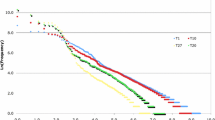Abstract
Information theory offers a means for analyzing some constraints on the reading and copying process in Old English. Entropy for strings of various lengths offers a baseline measure of the uncertainty involved in transmission of Old English texts, while avoiding the pitfalls of applying models of modern reading to early medieval practice. Analysis of lengthy prose and verse texts in Old English revealed uniformly high values for entropy at all string lengths. High entropies may be the result of the language's irregular orthography, poetic koiné, and several dialects and imply that the language may have been easy to write but difficult to read. The low redundancy of the language which its high entropy values indicate suggests that the reader of Old English played an enhanced role in “decoding” a text and may provide an explanation for the high variability in the transmission of Old English verse.
Katherine O'Brien O 'Keeffe is Professor of English at Texas A&M University and a co-director of its Interdisciplinary Group for Historical Literary Study.
Similar content being viewed by others
References
Bately, Janet M. The Angle-Saxon Chronicle: A Collaborative Edition. Vol. 3. MS A. Cambridge: D. S. Brewer, 1986.
Bethurum, Dorothy. The Homilies of Wulfstan. Oxford: 1957.
Bennett, William Ralph. Scientific and Engineering Problemsolving with the Computer. Englewood Cliffs, N.J.: Prentice-Hall, 1976.
Cherry, Colin. On Human Communication: A Review, a Survey, and a Criticism. Cambridge, MA: MIT Press, 1978.
Chaytor, Henry John. “The Medieval Reader and Textual Criticism.” Bulletin of the John Rylands Library, 26 (1941–42),49–56.
Clanchy, M. T. From Memory to Written Record: England 1066–1307. London: Edward Arnold, 1979.
Classen, E. and F. E. Harmer. An Angle-Saxon Chronicle. Manchester: Manchester University Press, 1926.
Clemoes, P. A. M. “Aelfric's Catholic Homilies, First Series.” Unpublished Doctoral Dissertation. Cambridge, 1955-56.
Dictionary of Old English Project, Centre for Medieval Studies, University of Toronto.
Dobbie, Elliott Van Kirk. The Angle-Saxon Minor Poems. ASPR 6. New York: Columbia University Press, 1942.
Dobbie, Elliot Van Kirk. Beowulf and Judith. ASPR 4. New York: Columbia University Press, 1953.
Hayes, Brian. “Computer Recreations.” Scientific American, 249,5(1983),18–28.
Krapp, George Philip. The Junius Manuscript. ASPR 1. New York: Columbia University Press, 1931.
Krapp, George Philip. The Vercelli Book. ASPR 2. New York: Columbia University Press, 1932a.
Krapp, George Philip. The Paris Psalter and the Meters of Boethius. ASPR 5. New York: Columbia University Press, 1932b.
Krapp, George Philip and Elliott Van Kirk Dobbie. The Exeter Book. ASPR 3. New York: Columbia University Press, 1936.
Meyer, Carl H. and Stephen M. Matyas. Cryptography: A New Dimension in Computer Data Security. New York: John Wiley & Sons, 1982.
Miller, T. The Old English Version of Bede's Ecclesiastical History of the English People. 4 vols. EETS 95, 96, 110, 111. London: Trubner and Co., 1890–98.
Morrish, J. J. “An Examination of Literacy and Learning in England in the Ninth Century.” Unpublished D.Phil. Thesis. Oxford, 1982.
O'Keeffe, Katherine O'Brien. “Orality and the Developing Text of Caedmon's Hymn.” Speculum, 62 (1987),1–20.
Ong, Walter J. Orality and Literacy: The Technologizing of the Word. London: Methuen, 1982.
Plummer, C. Two of the Saxon Chronicles Parallel. 2 vols. Oxford: Clarendon Press, 1965 (rpt. 1892–99).
Rositzke, H. A. The C-Text of the Old English Chronicles. Beiträge zur englischen Philologie 34. Bochum-Langendreer: Pöpinghaus, 1940.
Rypins, S. Three Old English Prose Texts. EETS 161. London, 1924.
Shannon, Claude. “The Mathematical Theory of Communication.” In The Mathematical Theory of Communication. Ed. Claude E. Shannon and Warren Weaver. Urbana: University of Illinois Press, 1963, pp. 3–91 (rpt. Bell System Technical Journal, 27 [1948]).
Shannon, Claude. “Communication Theory of Secrecy Systems.” Bell System Technical Journal, 28 (1949), 656–715.
Shannon, Claude. “Prediction and Entropy of Printed English.” Bell System Technical Journal, 30 (1950),50–64.
Smith, Frank. Understanding Reading: A Psycholinguistic Analysis of Reading and Learning to Read. 3rd ed. New York: Holt, Rinehart & Winston, 1982.
Author information
Authors and Affiliations
Additional information
William Rundell is Professor of Mathematics at Texas A&M University.
Rights and permissions
About this article
Cite this article
O'Keeffe, K.O., Rundell, W. An information-theoretic approach to the written transmission of old English. Comput Hum 23, 459–467 (1989). https://doi.org/10.1007/BF00130034
Issue Date:
DOI: https://doi.org/10.1007/BF00130034




